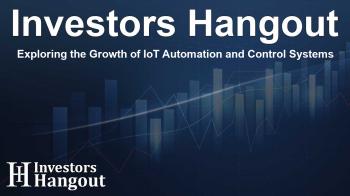Exploring the Growth of IoT Automation and Control Systems

Understanding the IoT Automation and Control Systems Market
The IoT Automation and Control Systems market is poised for remarkable growth, expected to reach USD 65,040 million by a specified future date, supported by a compound annual growth rate (CAGR) of 16.5%. This exciting expansion is largely attributed to advancements in technology and the increasing adoption of automated solutions across multiple sectors.
Key Growth Drivers
Several factors are instrumental in driving the growth of the IoT Automation and Control Systems market:
1. Rising Demand for Intelligent, Real-Time Control
Organizations and individual consumers alike are increasingly adopting IoT automation systems for their needs. These systems monitor and control environmental conditions, machinery, and various infrastructures, thereby enhancing operational efficiency.
2. Convergence of Advanced Technologies
The integration of affordable sensors, enhanced wireless connectivity through technologies like Wi-Fi and 5G, along with the availability of cloud-based platforms are facilitating more extensive deployment of IoT systems. This convergence not only makes implementations more feasible but also cost-effective.
3. Integrated Solutions from Vendors
Market players are focusing their efforts on creating scalable and interoperable automation solutions. These platforms typically combine hardware, software, and analytics, streamlining processes and boosting efficiency.
4. High Adoption Across Key Sectors
Industries such as manufacturing, energy, healthcare, smart homes, and transportation are particularly active in adopting IoT solutions. Automation in these areas leads to enhanced operational efficiencies and significant cost savings.
5. Strategic Partnerships and Collaborations
Collaborative efforts between technology providers, original equipment manufacturers, and governmental bodies are paving the way for innovations, pilot projects, and regulatory support that promotes the implementation of IoT technologies.
6. Global Digital Transformation
As companies worldwide undergo digital transformations, IoT automation systems are emerging as essential components for building smart infrastructures and connected ecosystems.
Market Trends Influencing Growth
The hardware segment remains pivotal to the growth of the IoT automation landscape. Essential devices such as sensors, actuators, microcontrollers, and edge gateways improve real-time data management. The evolution of smart factories, smart homes, and interconnected infrastructures underscores a growing demand for durable, energy-efficient, and scalable hardware solutions.
Simultaneously, software innovation is transforming how IoT systems function by enabling superior data interpretation, automation orchestration, and system integration. Companies are increasingly turning to platforms that facilitate real-time analytics and AI-driven decision-making, ensuring users can manage operations effectively and with minimal hassle.
In the residential context, smart home technologies are significantly shaping market demands. Consumers desire more energy-efficient, secure, and convenient home environments, prompting the adoption of IoT-enabled devices that facilitate remote control and enhanced automation.
Industrial Automation Adoption
The rising trend of industrial automation is amplifying the importance of IoT control systems. Manufacturing sectors are particularly inclined to harness real-time data and predictive analytics through interconnected machinery, driving productivity enhancements and minimizing downtime.
Sustainability and Energy Efficiency
With the increasing focus on sustainability, IoT automation systems are being utilized to optimize energy expenditure in both commercial environments and residences. Intelligent energy meters and demand response systems are blossoming, allowing for meticulous monitoring and control over energy usage, ultimately supporting green building initiatives and efforts to reduce carbon footprints.
Conclusion: Future Directions
The IoT Automation and Control Systems market presents vast potential for growth as different sectors continue to embrace technological advancements. As new applications and integrations emerge, stakeholders in the industry should remain adaptable and forward-thinking to leverage these innovations effectively.
Frequently Asked Questions
What is the projected market size for IoT Automation and Control Systems?
The market is projected to grow to USD 65,040 million by a specified future date.
What drives the growth of this market?
Key drivers include rising demand for intelligent systems, advanced technologies, and strategic partnerships.
Which sectors are adopting IoT solutions?
Key sectors include manufacturing, energy, healthcare, smart homes, and transportation.
How does hardware impact the market?
Hardware is crucial as it enables data collection and communication among systems enhancing operational efficiency.
What role does sustainability play?
Sustainability is vital, as IoT systems help optimize energy usage and promote eco-friendly practices.
About The Author
Contact Henry Turner privately here. Or send an email with ATTN: Henry Turner as the subject to contact@investorshangout.com.
About Investors Hangout
Investors Hangout is a leading online stock forum for financial discussion and learning, offering a wide range of free tools and resources. It draws in traders of all levels, who exchange market knowledge, investigate trading tactics, and keep an eye on industry developments in real time. Featuring financial articles, stock message boards, quotes, charts, company profiles, and live news updates. Through cooperative learning and a wealth of informational resources, it helps users from novices creating their first portfolios to experts honing their techniques. Join Investors Hangout today: https://investorshangout.com/
The content of this article is based on factual, publicly available information and does not represent legal, financial, or investment advice. Investors Hangout does not offer financial advice, and the author is not a licensed financial advisor. Consult a qualified advisor before making any financial or investment decisions based on this article. This article should not be considered advice to purchase, sell, or hold any securities or other investments. If any of the material provided here is inaccurate, please contact us for corrections.

